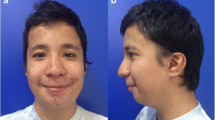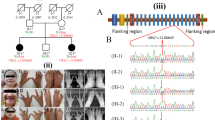Abstract
Hand-foot-genital syndrome (HFGS) is a rare autosomal dominant inherited syndrome characterized by limb malformations and urogenital defects. HFGS is caused by mutations in the HOXA13 gene. The aim of this study was to identify causative mutations in individuals and to explore the molecular pathogenesis in a Chinese family with HFGS. We performed Sanger sequencing and identified a recurrent missense mutation in the homeodomain (c.1123G>T, p.V375F) of HOXA13, molecular modelling predicted the mutation would affect DNA binding, and a luciferase reporter assay indicated that it impaired the ability of HOXA13 to activate transcription of the human EPHA7 promoter. This is the first report of the molecular basis for HFGS caused by missense mutations of HOXA13.



Similar content being viewed by others
References
Donnenfeld A. E., Schrager D. S. and Corson S. L. 1992 Update on a family with hand-foot-genital syndrome: hypospadias and urinary tract abnormalities in two boys from the fourth generation. Am. J. Med. Genet. 44, 482–484.
Fraenkel E., Rould M. A., Chambers K. A. and Pabo C. O. 1998 Engrailed homeodomain-DNA complex at 2.2 A resolution: a detailed view of the interface and comparison with other engrailed structures. J. Mol. Biol. 284, 351–361.
Frisén L., Lagerstedt K., Tapper-Persson M., Kockum I. and Nordenskjöld A. 2003 A novel duplication in the HOXA13 gene in a family with atypical hand-foot-genital syndrome. J. Med. Genet. 40, e49.
Fryns J. P., Vogels A., Decock P. and van den Berghe H. 1993 The hand-foot-genital syndrome: on the variable expression in affected males. Clin. Genet. 43, 232–234.
Gehring W. J., Qian Y. Q., Billeter M., Furukubo-Tokunaga K., Schier A. F., Resendez-Perez D. et al. 1994 Homeodomain-DNA recognition. Cell 78, 211–223.
Imagawa E., Kayserili H., Nishimura G., Nakashima M., Tsurusaki Y., Saitsu H. et al. 2014 Severe manifestations of hand-foot-genital syndrome associated with a novel HOXA13 mutation. Am. J. Med. Genet. A. 164A, 2398–2402.
Innis J. W., Goodman F. R., Bacchelli C., Williams T. M., Mortlock D. P., Sateesh P. et al. 2002 A HOXA13 allele with a missense mutation in the homeobox and a dinucleotide deletion in the promoter underlies Guttmacher syndrome. Hum. Mutat. 19, 573–574.
Innis J. W., Mortlock D., Chen Z., Ludwig M., Williams M. E., Williams T. M. et al. 2004 Polyalanine expansion in HOXA13: three new affected families and the molecular consequences in a mouse model. Hum. Mol. Genet. 13, 2841–2851.
Jorgensen E. M., Ruman J. I., Doherty L. and Taylor H. S. 2010 A novel mutation of HOXA13 in a family with hand-foot-genital syndrome and the role of polyalanine expansions in the spectrum of Müllerian fusion anomalies. Fertil. Steril. 94, 1235–1238.
Mortlock D. P. and Innis J. W. 1997 Mutation of HOXA13 in hand-foot-genital syndrome. Nat. Genet. 15, 179–180.
Owens K. M., Quinonez S. C., Thomas P. E., Keegan C. E., Lefebvre N., Roulston D. et al. 2013 Analysis of de novo HOXA13 polyalanine expansions supports replication slippage without repair in their generation. Am. J. Med. Genet. A. 161A, 1019–1027.
Parker L., Mangwani J., Wakeling E. and Singh D. 2011 Hallux valgus interphalangeus and a novel mutation in HOXA13. Part of the broadening spectrum of Hand-Foot-Genital syndrome. Foot Ankle Surg. 17, e28–e30.
Post L. C., Margulies E. H., Kuo A. and Innis J. W. 2000 Severe limb defects in Hypodactyly mice result from the expression of a novel, mutant HOXA13 protein. Dev. Biol. 217, 290–300.
Salsi V. and Zappavigna V. 2006 Hoxd13 and Hoxa13 directly control the expression of the EphA7 Ephrin tyrosine kinase receptor in developing limbs. J. Biol. Chem. 281, 1992–1999.
Scott M. P. 1993 A rational nomenclature for vertebrate homeobox (HOX) genes. Nucleic Acids Res. 21, 1687–1688.
Utsch B., McCabe C. D., Galbraith K., Gonzalez R., Born M., Dötsch J. et al. 2007 Molecular characterization of HOXA13 polyalanine expansion proteins in hand-foot-genital syndrome. Am. J. Med. Genet. A. 143A, 3161–3168.
Wallis M., Tsurusaki Y., Burgess T., Borzi P., Matsumoto N., Miyake N. et al. 2016 Dual genetic diagnoses: Atypical hand-foot-genital syndrome and developmental delay due to de novo mutations in HOXA13 and NRXN1. Am. J. Med. Genet. A. 170, 717–724.
Zhao X., Sun M., Zhao J., Leyva J. A., Zhu H., Yang W. et al. 2007 Mutations in HOXD13 underlie syndactyly type V and a novel brachydactyly-syndactyly syndrome. Am. J. Hum. Genet. 80, 361–371.
Zhang Y., Larsen C. A., Stadler H. S. and Ames J. B. 2011 Structural basis for sequence specific DNA binding and protein dimerization of HOXA13. PLoS One 6, e23069.
Acknowledgements
This work was supported by the Natural Science Foundation of China (nos 81000253, 81670896) and the Specialized Research Fund for the Doctoral Programme of Higher Education of China (no. 20102104120024). We thank all the family members for their generous participation.
Author information
Authors and Affiliations
Corresponding author
Additional information
Corresponding editor: Arun Kumar
Rights and permissions
About this article
Cite this article
Cao, L., Chen, C., Leng, Y. et al. A missense mutation of HOXA13 underlies hand-foot-genital syndrome in a Chinese family. J Genet 96, 647–652 (2017). https://doi.org/10.1007/s12041-017-0810-y
Received:
Accepted:
Published:
Issue Date:
DOI: https://doi.org/10.1007/s12041-017-0810-y




